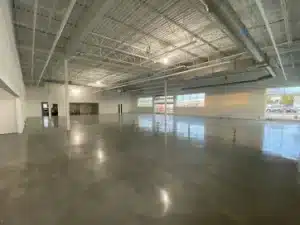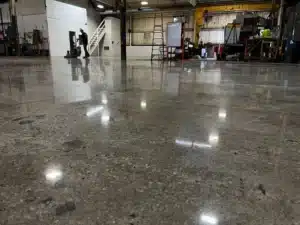Quick Guide: Why Choose Commercial Polished Concrete?
– Durability: Stands up to heavy traffic without showing wear.
– Low Maintenance: Easy to clean, reducing upkeep costs.
– Sustainability: Made from natural materials, reducing environmental impact.
– Aesthetic Appeal: Sleek, modern look that can be customized.
– Cost-Effective: Long-term savings over other flooring options.
Introduction
When searching for a flooring solution that meets the needs of a sustainable design, durability, and aesthetic flexibility, commercial polished concrete emerges as a standout choice. This guide is your quick reference to understanding why polished concrete is not only an economical choice for commercial spaces but also an eco-friendly option that aligns with sustainable building practices.
In commercial construction and design, where the balance between cost, aesthetic appeal, and environmental impact is crucial, polished concrete offers a solution that ticks all the right boxes. Its robustness ensures it can withstand the rigors of heavy foot traffic, making it ideal for retail stores, restaurants, and warehouses, among other commercial spaces. Additionally, its low maintenance needs and high durability translate into significant long-term savings.
But perhaps what is most appealing about polished concrete, especially to the environmentally-conscious architect or builder, is its sustainability. Polished concrete uses existing concrete slabs, minimizing the demand for new materials and thereby embodying the essence of eco-friendly design. It also helps conserve energy by enhancing natural lighting thanks to its high reflectivity, reducing the need for artificial lighting, and its thermal mass helps regulate indoor temperatures.

Understanding Polished Concrete
When we talk about commercial polished concrete, we’re diving into a world where durability meets design in a spectacular fashion. But what exactly goes into creating this sleek, resilient flooring option? Let’s break it down into simple parts: the process, mechanically ground, honed, polished, and the role of bonded abrasives.
The Process
Imagine taking a rough, unremarkable piece of concrete and transforming it into a shiny, smooth surface that’s tough as nails. That’s what the polished concrete process is all about. It’s a bit like turning a diamond in the rough into a gleaming gemstone.
- Mechanically Ground: First, we take heavy-duty machines and start grinding down the concrete. This isn’t just any grinding – we use diamond-embedded pads that can really tackle the concrete’s surface, smoothing out the roughness and preparing it for the next steps.
- Honed: After grinding, the surface is already looking better, but we’re not done yet. Now, we hone it. This involves using finer grits that continue to smooth the surface and start to bring out the natural beauty of the concrete. It’s like using finer sandpaper to get that wood project perfectly smooth before you varnish it.
- Polished: This is where the magic happens. We switch to even finer grits, and this is when the concrete starts to really shine. It’s not just about aesthetics, though. This polishing makes the floor more resistant to stains and wear.
The Role of Bonded Abrasives
You might be wondering what’s doing all the hard work in these steps. The answer is bonded abrasives. These are the diamond pads or discs we mentioned, and they’re crucial to the process. They cut through the concrete, smoothing and polishing it to perfection.
Why It Matters
But why go through all this trouble for a floor? Because commercial polished concrete isn’t just any floor. It’s incredibly durable, meaning it can handle the heavy traffic and wear that commercial spaces endure. It’s low maintenance, saving businesses time and money. And let’s not forget the aesthetic versatility – it can be customized to fit any design vision.
In a nutshell, polished concrete is a practical, stylish flooring option that stands up to the demands of commercial spaces. It embodies sustainability, with a process that minimizes waste and maximizes efficiency. Whether you’re outfitting a warehouse, retail space, or office, polished concrete offers a blend of benefits that’s hard to beat.
So, when you step onto a polished concrete floor, remember the journey it’s been on – from a basic slab of concrete to a polished, durable surface ready to take on the challenges of a commercial environment.
Benefits of Polished Concrete in Commercial Spaces
Polished concrete isn’t just a floor; it’s a resilient foundation that stands up to the bustling activity in commercial spaces. Let’s dive into why commercial polished concrete is a smart choice for businesses.
Durability
Imagine a floor that can take the weight of heavy machinery, endure high foot traffic, and still look good as new. Polished concrete floors are incredibly tough. They reach a hardness level of 7 on the Mohs scale, making them nearly as hard as diamond. This means less worry about damage and more focus on productivity.
Aesthetic Value
First impressions matter. Polished concrete shines with a gloss that can mirror the overhead lights, adding a bright, professional look to any space. And it’s not just about the shine; you can add colors and designs during the polishing process. This flexibility allows you to align the floor with your brand or create a welcoming atmosphere for customers and employees alike.
Economy
Cost-effective doesn’t have to mean cheap. With polished concrete, you’re investing in a long-term flooring solution. There’s no need for expensive installations or materials; you’re working with what you already have – your existing concrete slab. And when it comes to upkeep, the costs are minimal. A simple sweep and mop are all it takes to maintain its luster, making it a smart financial decision for any business.
Safety
Despite its glossy appearance, polished concrete is designed to be slip-resistant, even when wet. This inherent safety feature is crucial in preventing accidents in commercial settings. Plus, its enhanced reflectivity improves visibility, making it easier for employees and customers to navigate the space safely.
Cleanliness
Say goodbye to dusty floors. The polishing process transforms the concrete into a tight, dense surface that doesn’t shed. This means a cleaner environment for your products and a healthier air quality for everyone. Easy to clean and resistant to stains, polished concrete floors stand up to the demands of busy commercial spaces without compromising on hygiene.
In conclusion, polished concrete floors offer a blend of durability, beauty, cost efficiency, safety, and cleanliness that’s hard to match. They’re not just floors; they’re a smart investment in your commercial space’s future. Let’s explore how to achieve that perfect shine and durability through the polishing process.

How to Polish Commercial Concrete
Polishing commercial concrete might sound complex, but it’s like giving your floor a spa day—except with more grinding and less relaxation. Here’s how to transform a dull concrete slab into a shiny, durable surface that reflects your business’s professionalism.
Prepare Area
First things first, clear the deck. Remove every bit of furniture, fixture, and dust bunny. This stage is crucial because anything left behind can affect the polishing process. It’s not just about making room for the equipment; it’s about ensuring nothing interferes with the concrete’s transformation.
Coarse Grit
Think of this step as the heavy lifting. Using a concrete grinder equipped with coarse-grit diamonds, this phase is all about erasing the rough edges, literally. It smooths out bumps, levels the surface, and prepares the concrete for finer work. It’s like sketching out the big picture before adding in the details.
Fine Grit
With the surface leveled, it’s time to refine. Switching to a finer grit, this step begins to polish the concrete. It starts to bring out a bit of shine but mainly focuses on smoothing the surface even further. This stage is akin to adding layers of paint over that initial sketch, making everything look more cohesive.
Extra-Fine Grit
Now, we’re getting into the nitty-gritty, or should we say, the shiny-shiny? Extra-fine grit is where the real polishing happens. This step is where the concrete starts to reflect light, showing off a sheen that wasn’t there before. It’s the detailed brushwork that turns a painting from good to great.
Surface Polish Coat
Finally, to protect and enhance the polished concrete, a surface polish coat is applied. This sealant not only increases the floor’s durability but also its resistance to stains and scratches. It’s the varnish that protects the painting, ensuring it can withstand the test of time and traffic.
By following these steps, commercial polished concrete floors achieve a balance of beauty and resilience. They’re not just floors; they become a statement piece in any commercial space, reflecting the quality and care of your business.
As we delve into comparisons with other flooring options, keep in mind the unique advantages polished concrete offers, especially in terms of long-term value and maintenance.
Polished Concrete vs. Other Flooring Options
When choosing flooring for a commercial space, it’s important to weigh all options. Let’s compare polished concrete to other popular choices like Epoxy and Vinyl Composition Tile (VCT), focusing on cost over time and maintenance.
Epoxy Flooring
Epoxy is a strong and durable option that can resist stains and spills, making it a popular choice for areas that experience heavy foot traffic or potential spillages. However, while epoxy floors are durable, they don’t last forever. Over time, they can start to chip and peel, requiring a complete reapplication to maintain their appearance and functionality. This can add up in terms of both cost and time.
Cost Over Time
When we talk about cost over time, polished concrete stands out for its longevity and minimal maintenance requirements. Unlike VCT, which needs regular upkeep, or epoxy, which may require reapplication, commercial polished concrete, once installed and polished, needs only basic cleaning to maintain its appearance. This can result in significant savings over the lifespan of the floor.
Maintenance
Maintenance is where polished concrete truly shines. It doesn’t harbor dust, allergens, or mold because it’s a solid surface with no seams or grout lines. Cleaning is as simple as a quick sweep and a damp mop. There’s no need for waxing, sealing, or stripping. This ease of maintenance not only saves time and money but also makes polished concrete an attractive option for busy commercial spaces.
In summary, while epoxy and VCT have their places in the commercial flooring market, polished concrete offers a blend of durability, low maintenance, and cost-effectiveness over time that’s hard to beat. Its ability to withstand heavy traffic and maintain its luster with minimal upkeep makes it a smart choice for businesses looking to invest in their space’s long-term appearance and functionality.
Choosing the Right Polished Concrete for Your Commercial Space
When it comes to selecting the perfect commercial polished concrete finish for your business, it’s like picking the right tool for the job. Each option has its unique benefits tailored to different needs and aesthetics. Let’s break it down into three main finishes: Industrial, Commercial, and Premium, along with a look at staining options and aggregate exposure.
Industrial Finish
Ideal for: Warehouses, factories, and spaces where function beats form.
- Characteristics: More about durability than looks. It’s less about the shine and more about withstanding heavy machinery and spills.
- Benefits: Super tough. Can handle almost anything you throw at it.
Commercial Finish
Ideal for: Retail spaces, offices, and areas with moderate foot traffic.
- Characteristics: Strikes a balance between durability and aesthetics. It’s got a nice sheen that reflects well on your business.
- Benefits: Easy to clean and maintain. Looks professional and welcoming.
Premium Finish
Ideal for: Showrooms, high-end retail, and spaces where appearance is key.
- Characteristics: High-gloss finish that makes the space brighter and more inviting. The top tier in polished concrete aesthetics.
- Benefits: Impressively beautiful. Can make your space look bigger and brighter.
Staining Options
- Why it matters: Color can set a mood, match your brand colors, or define different areas within your space.
- Options: From subtle earth tones to vibrant hues, stains can transform the look of your concrete floor.
Aggregate Exposure
- What it is: The amount of aggregate (stone or sand in the concrete mix) that’s visible on the surface after polishing.
- Levels:
- Minimal: For a sleek, modern look.
- Medium: Adds character with a bit more texture.
- Full: Showcases the natural beauty of the concrete with a unique, rugged appearance.
Choosing the right finish and options for your commercial space isn’t just about what looks good. It’s about what works best for your business’s needs. Whether you need a floor that can handle the hustle and bustle of a busy warehouse or a showroom floor that dazzles your customers, there’s a polished concrete solution that fits the bill.
The best choice takes into account not just the initial look but also how the floor will be used day-to-day. Durability, maintenance, and aesthetics all play a crucial role in finding the perfect balance for your space.
As you consider your options, think about the long-term value and how each choice aligns with your business goals. Commercial polished concrete is an investment in your space’s future, combining functionality with style in a way that few other flooring options can match.
Next, let’s dive into some frequently asked questions about commercial polished concrete to clear up any uncertainties and help you make an informed decision.

Frequently Asked Questions about Commercial Polished Concrete
When considering commercial polished concrete for your business, you likely have a few questions. Let’s tackle some of the most common inquiries to give you a clearer picture.
Can Polished Concrete Be Used in Commercial Kitchens?
Yes, polished concrete can be used in commercial kitchens. It’s a robust choice due to its resistance to high foot traffic, spills, and stains. Polished concrete doesn’t harbor bacteria, making it a hygienic option. Plus, its ease of cleaning helps maintain the strict cleanliness standards required in kitchen environments. However, for added safety, anti-slip conditioners can be applied to ensure the surface remains slip-resistant, even in wet conditions.
Why Is Polished Concrete Considered Expensive?
At first glance, polished concrete might seem expensive compared to other flooring options. This perception is due to the specialized process it undergoes – involving mechanically grinding, honing, and polishing the concrete, along with applying densifiers and sealers. The equipment and expertise required for this process contribute to the cost.
However, it’s crucial to consider the long-term savings. Polished concrete floors are incredibly durable and require minimal maintenance, which means lower ongoing costs. They’re also long-lasting, often outliving the buildings they’re in. When you factor in these long-term benefits, polished concrete offers excellent value for money.
Is Polished Concrete or Epoxy Cheaper in the Long Run?
Comparing polished concrete to epoxy flooring in terms of long-term costs, polished concrete often comes out ahead. Epoxy might have a lower initial installation cost, but it requires more maintenance over its lifespan, which can add up. Epoxy floors also tend to have a shorter lifespan compared to polished concrete, meaning they’ll likely need to be replaced sooner.
Polished concrete, on the other hand, with its minimal maintenance requirements and exceptional durability, often proves to be more cost-effective over time. Not only does it withstand heavy traffic and industrial wear and tear, but it also retains its aesthetic appeal for decades with proper care.
By addressing these common questions, we hope to have provided you with valuable insights into the benefits and considerations of choosing commercial polished concrete for your space. Investing in the right flooring is not just about the initial cost but also about considering the long-term value and savings it offers.
Conclusion
As we wrap up our comprehensive guide on commercial polished concrete, it’s clear that this flooring option stands out for its durability, aesthetic appeal, and long-term value. At Topcoat Services, we’re committed to delivering high-quality polished concrete services that not only meet but exceed your expectations. Our expertise and dedication to sustainable design ensure that your investment in polished concrete flooring is both a smart and eco-friendly choice.
Long-Term Value: Choosing commercial polished concrete is an investment in the future of your commercial space. Its durability means it can withstand heavy foot traffic and industrial operations, reducing the need for frequent repairs or replacements. This longevity translates into significant cost savings over time, making polished concrete a financially wise choice for any business.
Environmental Benefits: At Topcoat Services, we’re passionate about sustainability. Polished concrete floors contribute to this by utilizing existing concrete slabs, minimizing the demand for new materials. The high reflectivity of polished concrete enhances natural lighting, reducing the need for artificial lighting and thereby saving energy. Furthermore, the thermal mass of concrete aids in regulating indoor temperatures, decreasing the reliance on heating and cooling systems. These factors make polished concrete an environmentally friendly option that aligns with green building practices.
In conclusion, the benefits of opting for commercial polished concrete with Topcoat Services are manifold. Not only do you get a durable, aesthetically pleasing floor, but you also make a choice that benefits the environment and offers long-term savings. Whether you’re renovating an existing space or building a new one, polished concrete is a flooring solution that stands the test of time in both style and function.
Ready to transform your commercial space with polished concrete? Let us guide you through the process and help you make a choice that aligns with your business’s values and needs. Learn more about our services and how we can assist you.
At Topcoat Services, we’re not just about laying floors; we’re about laying the foundation for your business’s success.









